THE IDEAL PROPORTIONS FOR A PRINCESS CUT DIAMOND
IDEAL PROPORTIONS FOR A PRINCESS CUT DIAMOND?
This post contains affiliate links. If you use these links to buy something I may earn a commission. Thanks! As an Amazon Associate I also earn from qualifying purchases.

There are tons of articles on the ideal cut diamond. But unfortunately they all pertain to the round cut, or brilliant cut diamond.
In fact, if you look at “cut” in the 4C’s of diamonds, you’ll see that everything is about the round stone: table depth, mm width, crown, angles, pavilion…
It’s all ROUND.
There isn’t a mention about other fancy cuts (fancy cuts are every other cut of diamond except the round).
See image below…

Those guidelines don’t help you much if you’re buying a princess cut diamond (square or rectangular cut with 50-58 facets).
I’ve had a lot of people write in over the years asking about the “standards” and “specifications” for fancy cuts like the princess cut diamond.
So is there an ideal cut?

How do you know if a princess cut diamond is cut well? Is it worth buying? Is it a crappy cut? Are you getting ripped off?
The truth is, there really isn’t an “exact” guideline for princess cuts (or any fancy cut for that matter).
When it comes to princess cut diamonds, it’s not entirely about just the table and depth percentages like many people would think. There are a lot of things to take into consideration because of the shape and cutting style.
There are also many different cuts of princess cuts. The faceting on the pavilion changes.
See the facet arrangement below…

There can be 2 chevrons, 3 chevrons, even 4 chevrons… The bezel on the top (next to the star and crown facets) change. It’s all different. Plus, some stones are square, some are rectangle. It all comes into play and makes it very difficult to nail down.
Look at more examples of different princess cut diamonds below…

Round stones (a.k.a. brilliant cuts) are easy to judge because they are all cut with the same faceting and guidelines. Plus they are symmetrical in design (which also makes them the most brilliant cut of them all).
But princess cuts, pear cuts, emerald cuts, and trilliant cuts (just to name a few) aren’t so lucky. They can be long, short, thick, wide, deep… Because when it comes to fancy, it’s all about “preference“. Some people like a longer stone. There is no “ideal” shape. It’s just opinion.
Take a look at the different ratios of princess cuts and you’ll see how some are square 1.00 L x W, while some start to look more rectangular 1.10 ratio, 1.20 ratio…

One shape really isn’t better or worse than the other.
The funny thing is, when most people think about princess cuts, they actually think about a square cut stone, when in fact, just about every princess cut on the market is NOT exactly square.
Look at the measurements (listed in millimeters on a diamond report: length, width and depth) to see for yourself…

Some come close, but close is not exact.
A truly square stone would be (as an example) listed as: 5.85 x 5.85 x 4.50.
They aren’t exact because of the way diamond cutter’s cut the stone. They strive to maintain carat weight and quality whenever possible. So cut is often compromised.
Ideal diamond dimensions:
Doing a search online for the ideal standards of princess cut diamonds, you’ll find a lot of controversy and confusion. Nobody can agree on a set of numbers that will accommodate every cut and shape of stone: table: 65-75%, depth: 65-75% ???
Or is it: table: 69-74%, depth: 69-74% ???
How about: table: 62-80%, depth: 63-68% ???
It’s all over the board.
The reason it’s different is simple: There are no set rules or guidelines.
GIA clearly states on their website:
“An internationally accepted system for visually evaluating the appearance of fancy-cut diamonds does not exist at this time. At GIA, research is underway to develop the basic concepts for designing and implementing such a system.” (see here)
Some websites have nice little charts and graphs, others list percentages in their forums. Still others (like Blue Nile) has “Astor ideal cuts“…
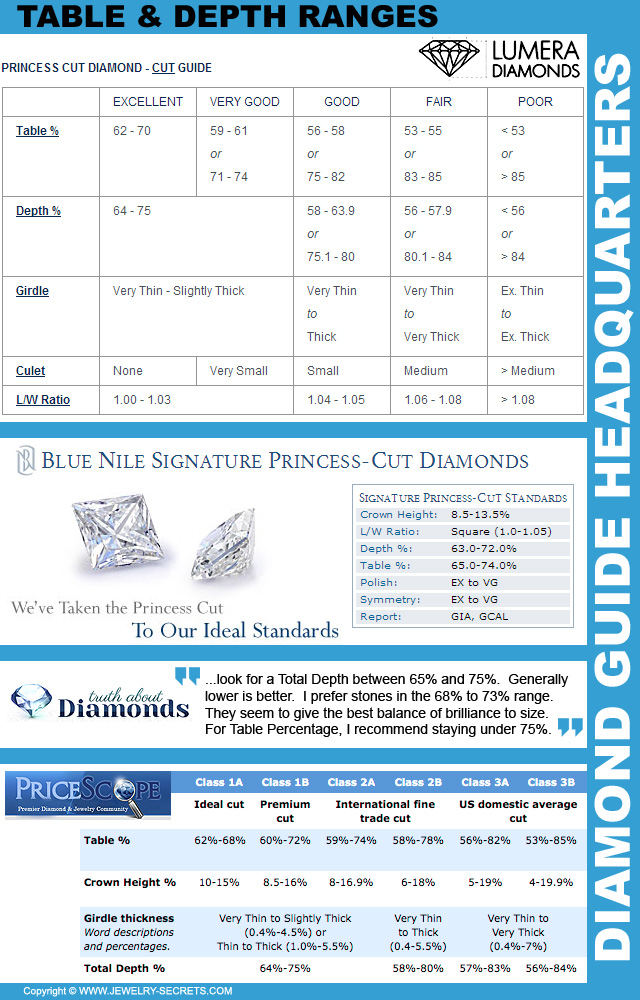
But if you keep looking, you’ll find more.
I went to 10 different websites and got 10 different proportion ranges.
So I thought I’d take an average of them… But that got too confusing. I had to create a spreadsheet just to track the differences…

An average is probably around 65-75% table and depth.
But it doesn’t happen that way either…
And that’s because ideal cut diamonds are not just a couple of numbers. It also has to do with beauty, appearance, light, sparkle, and brilliance. Something that “numbers” can’t give you.
But jewelers like James Allen do sell “ideal cut princess cuts“, like so…
James Allen do sell “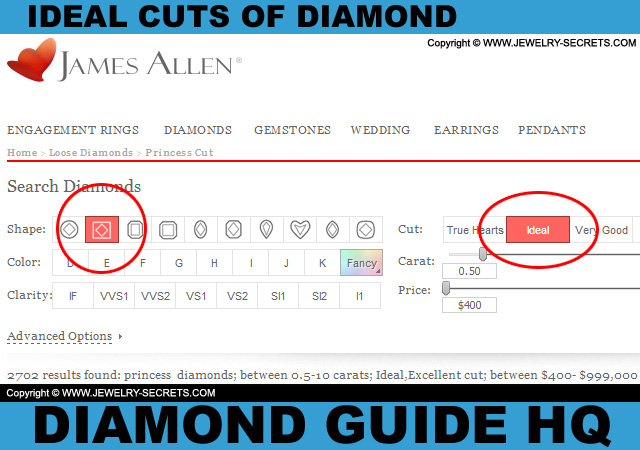
So what are they going by?
Excellent polish and symmetry? Are they looking at table and depth? Angles?
For example:
I pull up this princess cut diamond here. It’s GIA certified, 1.50 princess cut, IF clarity, E color, with 75% table, 74.4% depth, and it’s listed as “ideal“…
| CARAT WEIGHT, CLARITY, COLOR, CUT, CERTIFIED | PRICE | VIEW |
| 1.50, IF, E, IDEAL, GIA | $24,930 | VIEW |
Example two:
And then I pull up an AGS certified princess cut, .70 carat, VVS2 clarity, F color, 69.3% table, 77.3 depth, ideal cut…
| CARAT WEIGHT, CLARITY, COLOR, CUT, CERTIFIED | PRICE | VIEW |
| .70, VVS2, F, IDEAL, AGS | $3,040 | VIEW |
Sure they could go by the “ideal” listed on AGS’s diamond reports.
But what about GIA’s???
What do they do then?
AGS clearly states on many of their reports that a cut grade of 0 is “ideal”. (Do note that princess cuts are not called princess cuts on a diamond report, they are actually called “modified brilliant cuts“). So there must a real ideal cut then.?
Right?
James Allen says they strive for these standards; table: 65-75%, depth: 65-75%, polish/symmetry: very good/excellent…
So there are some guidelines.
(You would think this would be public knowledge.)
Blue Nile, as shown above, calls their ideal cut stones “Astor” (used to be called “Signature Series“). They list their princess cut ideal range as: table: 65-74%, depth: 63-72%.
So who’s right? Who’s wrong? Is there a right or wrong?
With no real set standards, it’s anyone’s game.
AGS ideal 0 grade.

Triple 000
AGS has a triple 000 score that they give the best of the best diamonds. Very few diamonds in the world get 000 ratings. Triple 000 means that the diamond is the best of not only cut, but also color and clarity. Like so:
- Cut Grade: 0 (Ideal)
- Color Grade: 0 (D)
- Clarity Grade: 0 (IF or Flawless)
The cut grade is the main one to look at if you’re looking for an ideal cut. The cut grade gets scored for light performance, polish & symmetry. They are all highly important in getting an AGS ideal 0 grade.
The AGS website says:
“This term (triple 000) has been used to describe a diamond which has the highest grade (0) for proportions, symmetry, and polish. However, the AGS Performance grading for the cut of a diamond now assesses the performance, proportions, and finish. That’s still three categories, but the Finish includes both symmetry and polish, technically addressing four categories.
According to the Diamond Standards of the American Gem Society, for a diamond to receive a grade of AGS Triple Zero®, it must achieve an AGS Ideal® grade for its cut, color, and clarity. This means the best cut of a colorless and flawless diamond of any size.” (see here)
So I wrote AGS inquiring about their ideal cut proportions.
This is their response…
AGS responds:
“The AGS cut grade is based on light performance, proportion, and finish factors. Our light performance factors are calculated using our metric which traces how rays of light interact with the diamond, and how they return to your eye (brightness, dispersion, contrast, and leakage). This means the AGS cut grade gives you a good idea of how the stone will look to the naked eye. Other grading systems often only consider proportion factors (the measurements and angles) and do not trace the rays of light in the diamond. That being said, since a range of proportions have an impact on light performance, certain combinations of proportions are likely to yield more favorable cut grade results. Because the princess cut often has three or four tiers of facets, it increases the complexity of the cut and the angles/azimuth of these tiers become important and dependant on one another. It becomes much more than table and depth percentages. I have attached an excel file table for your reference, to give you an idea of what combinations of proportions are likely to yield the AGS 000 cut grade.”
AGS spreadsheet:
So I pulled up the spreadsheet they sent me. There are 2314 different possibilities and combinations of AGS 000 “ideal” specifications for just princess cuts with 2 chevrons.
Here’s a screenshot…

So not only are they looking at table and depth, but this spreadsheet lists: chevrons, table, crown 1, crown 2, pavilion 1, pavilion 2, upper pavilion ratio, lower pavilion ratio, chevron azimuth 1, chevron azimuth 2, chevron azimuth 3, chevron azimuth 4, chevron azimuths, expected light performance grade.
Again, that sheet is just for one particular cut of princess cut (with 2 chevrons). When in fact there are at least 9 different varieties…
That’s a lot of numbers.
To get a better idea of the leeway they were using for this one cut, I sorted them by table percentage, and then pavilion depth percent to find an average range between them.
This is what I found: table: 55 – 75%, pavilion depth: 52.13 – 65.43%

The sad thing is, none of this is very helpful without the other 7 criteria. And even then it’s impossible to understand.
AGS told me:
“The chevron azimuths and pavilion facets ratio are calculated using high-def non-contact optical scanners. It’s complex and you can’t determine whether a princess cut is ideal based upon proportions only.”
That’s pretty much what GIA does for their NEW cut grading on rounds; beauty, light and sparkle add much to the overall grade.
So I say, leave the percentages to the people that grade or sell them. You’ll just drive yourself batty.
Instead, look at the beauty of the stone. Princess cuts are highly popular because they are the second most brilliant stone there is. They sparkle like crazy.
And not only are they brilliant, but princess cuts tend to be cheaper as well.
Compare prices
Compare a princess cut diamond to a brilliant cut below, with the exact same clarity, color and carat weight… (1.00, VS1, F, ideal cut)
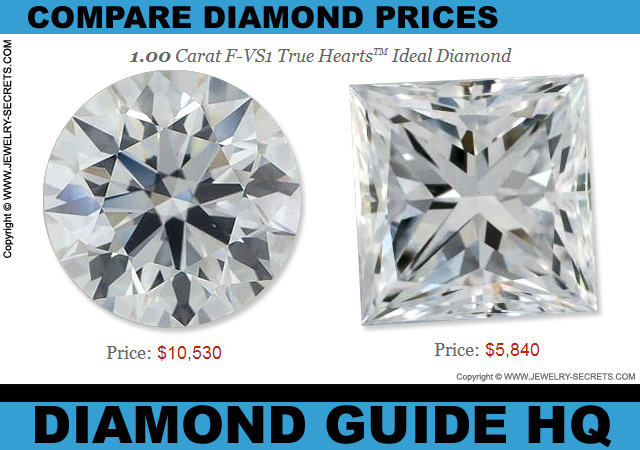
| CARAT WEIGHT, CLARITY, COLOR, CUT, CERTIFIED | PRICE | VIEW |
| 1.00, VS1, F, IDEAL, GIA | $10,530 | VIEW |
| 1.00, VS1, F, IDEAL, GIA | $5,840 | VIEW |
Those are some BIG savings.
The round is almost double the price. WOW.
Not only are princess cuts usually less expensive, but because the corners are square, they tend to look bigger as well.
Compare a princess cut to a brilliant cut diamond below. The princess cut looks HUGE.

Now, If you really want to determine cut…
If you want to know what the best cut to get is, look at the diamond report.
Reputable dealers like James Allen or Blue Nile both sell AGS and GIA certified stones, and they also have “ideal” cut standards with their True Hearts and Astor cut.
That’s your best bet.
I will say I am leaning more towards AGS stones when it comes to Ideal. With AGS you CAN get closer to perfection, because they do take it a step farther than GIA. They will list whether a princess cut is ideal or not. Look for a cut grade of 0 and you’ll be fine.
A princess cut with triple 0’s though (if you can find one) is as ideal as any stone could be… That’s ideal in every way. And at this time, neither Blue Nile nor James Allen had one single princess cut stone to show, they’re that rare. (again, this is flawless or internally flawless clarity, D color, and an ideal cut.)
One more thing…
While you’re looking at these reports, look at the culet and girdle as well…
Girdle…
The girdle of a princess cut should be graded either “Very Thin, Thin, Medium, or Slightly Thick“. That way it’s not too thin to easily chip, and the prongs have enough flat surface edge to grip and hold your diamond securely.
P.S.
I also highly advise getting v-tipped prongs on those corners versus just standard round prongs that can chip the stone. See v-tips below…

Culet…
The culet of a princess cut should be listed as “None” or “Very Small“.
That way, it doesn’t interfere with the look of the stone (won’t look like a hole in the diamond), and it won’t let light leak out the bottom.
My favorite combo:
Head over to James Allen and look at their princess cuts. You can choose ideal cuts or True Hearts (their premium cut), as well as other things like: clarity, color (my favorite combo is VS1, E), polish, symmetry, certificate (AGS or GIA) and fluorescence (I would advise against any fluorescence, or NO fluorescence) to narrow things down.
Here is a princess cut diamond that is top of the line.
It’s AGS certified, VS1, E, with an ideal cut (incredible diamond).
| CARAT WEIGHT, CLARITY, COLOR, CUT, CERTIFIED | PRICE | VIEW |
| 1.01, VS1, E, IDEAL, GIA | $6,600 | VIEW |
And that price is a STEAL.
So all in all, don’t worry so much about the numbers. Let the graders worry about that. Just make sure that you do buy a certified diamond (AGS or GIA only).
Because trying to figure it out yourself, may cause more confusion than good.
See more ideal princess cuts here at James Allen.
Cheers.


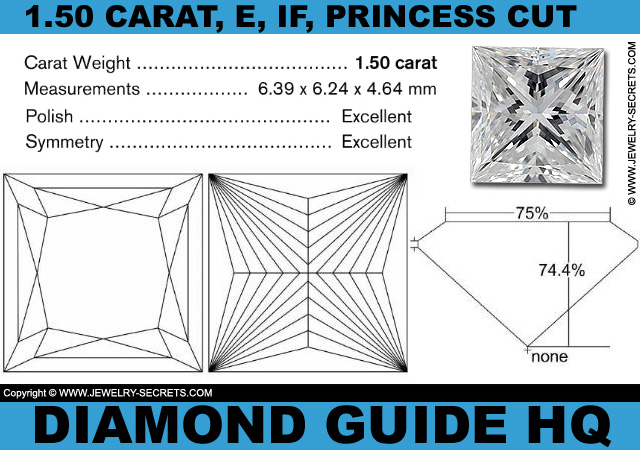











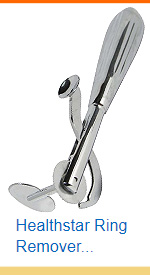

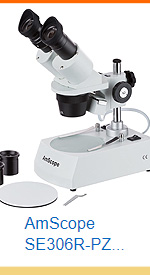




Thank you very much for this amazing job of research. I had a look on this for a completely different reason than buy more for the production.
Thank again